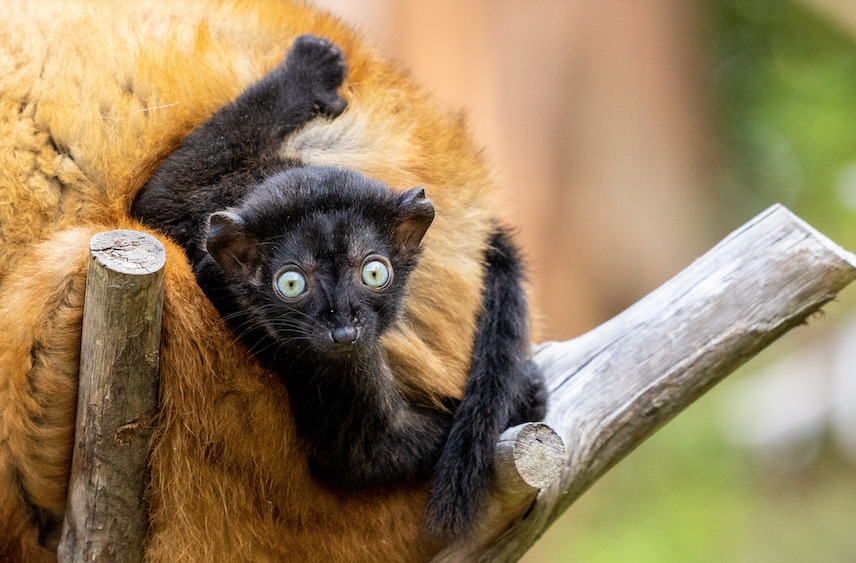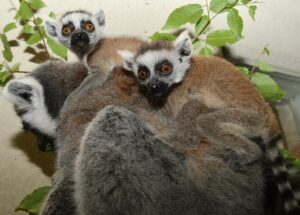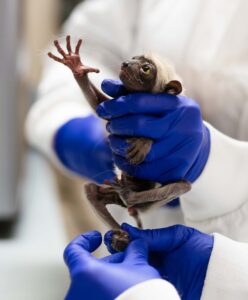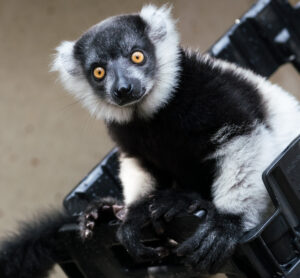Gatsby, Presley, Mangamaso, Egeria, Domestic Chicken, Marshmallow, Sputnik, Poe—if you visit the Duke Lemur Center, you will likely hear a plethora of names that range from obscure to something you might see on a kindergarten attendance list. While some of these names seem absurd out of context, they’re rooted in decades of tradition and species-specific themes that help staff and volunteers keep track of the almost 250 primates living at the DLC.

Blue-eyed black lemur infant McAvoy, named after Scottish actor James McAvoy. Photo by Sara Nicholson.
While the lemurs do not know or respond to their names, having unique monikers for each animal helps the DLC keep detailed records of every primate that has lived in our care since our founding in 1966. These records include family trees, veterinary history, and notes on the ins and outs of each lemur’s day-to-day life. Names cannot be repeated, ensuring that records of two different animals don’t get confused.
Species-specific naming themes allow for easy communication across departments. For instance, if a veterinarian hears a radio call about Goose or Raven, they know that the animal in question is a fat-tailed dwarf lemur. Sometimes, a given family of lemurs will share a more specific theme, like soda names, types of chickens, or toxic plants, which can tie siblings and parents together even after offspring reach sexual maturity and leave their natal group. On an individual level, names can celebrate something special about a specific lemur or capture an infant’s personality.
Let’s get into the nitty gritty: how do infants of each species get their names?
First up are the ring-tailed lemurs, whose naming themes have changed over the past few decades. Originally, all ring-tailed lemurs received Greek names, like Persephone and Nikos. As the ring-tailed lemur population at the DLC grew, certain families split off into their own unique themes—Sprite and all of her offspring are named after sodas, like Sierra Mist and Sarsaparilla, while Liesl and all of her offspring receive Austrian names, like Edelweiss and Gretl. Starting in 2021, the ring-tailed naming convention has switched to literary names, bringing us ring-tails like Atticus (To Kill a Mockingbird), Gatsby (The Great Gatsby), and Cirilla (The Witcher).

Ring-tailed lemur twins Merry and Eowyn, named after Lord of the Rings characters. Photo by David Haring.
Coquerel’s sifakas receive Roman names, ranging from emperors and consorts to cities and gods. The first two infants born in the 2025 baby season, Arcadius and Majorian, were both named after Roman emperors, while previous years’ infants Minerva and Pax both share names with ancient Roman goddesses. Egeria, who was born in 2023, was named by the Cooke Family, longtime supporters of the DLC’s in-situ conservation programs in the SAVA region of Madagascar. The family, who placed the winning bid on naming rights through the DLC’s online auction, had fun brainstorming names together and ultimately settled on Egeria, a consort of Roman king Numa who was rumored to by a nymph. “Egeria’s special connections to nature stood out to us, so we felt the name was a perfect fit for a little lemur,” Julie Cooke explained.

Coquerel’s sifaka Egeria, named by the Cooke Family. Photo by Sara Sorraia.
Both red ruffed and black and white ruffed lemurs are given celestial or space-inspired names. Most recently, twins Kepler and Spitzer were named after two of NASA’s space telescopes. Ruffed lemurs often share names with astronauts, such as Buzz (Aldrin) and Mae (Jemison), or celestial phenomena, such as Halley (of the eponymous comet) and Borealis (like the northern lights).

Black and white ruffed lemur Ripley, named after the protagonist of the Alien film series. Photo by Sara Sorraia.
Blue-eyed black lemurs, the most critically endangered species at the DLC, are usually named after blue-eyed celebrities. That’s why you’ll hear keepers walking around the center saying things like “well, (James) McAvoy just didn’t like his broccoli today, but (Mark) Hamill ate it all right up!” Famous inspirations range from sports (Brady, after quarterback Tom) to movies (Kidman, after actress Nicole) to music (Presley, like the King of Rock and Roll).
A special family of blue-eyed black lemurs at the DLC receive Malagasy names. Velona (meaning “living” or “alive”) and Mangamaso (meaning “blue eyes”), two members of the DLC’s blue-eyed black lemur colony, were born at Parc Ivoloina, a nonprofit nature center in eastern Madagascar, and traveled to North Carolina in 2017 to expand the gene pool of this critically endangered species in human care. Two more members of this family have been born since the pair’s arrival in Durham: Ranomasina (meaning “sea” or “ocean”) and Malala (meaning “beloved”).

Blue-eyed black lemur Gellar, named after actress Sarah Michelle Gellar of Buffy the Vampire Slayer fame. Photo by David Haring.
Mongoose lemurs are given Spanish names. Members of this critically endangered species at the DLC sport names such as Bonita, Carolina, Juanito, and Rico. Fun fact: in the wild, mongoose lemur mates tend to stick together year after year. Monogamy is not common among lemurs and this behavior is being studied in non-invasive research at the DLC!

Mongoose lemur Nacho clinging to mom Carolina. Photo by David Haring.
Crowned lemurs receive Egyptian names. These include gods and goddesses, such as Seshat (goddess of writing and wisdom) and Ma’at (goddess of law and justice), as well as historical figures, such as Nefertiti. Crowned lemur Sanura’s name means “kitten,” and her son’s name also has a feline flair: The ancient Egyptian cat Nedjem (“sweetie” or “sweet one”), who lived during the reign of Thutmose III, is the first known cat in history to have been given a name.

Crowned lemur infant Hapi, named after the god of the Nile River.
In the nocturnal realm, we name fat-tailed dwarf lemurs after birds and gray mouse lemurs after flowers and plants. Since these small nocturnal lemurs regularly have twins and triplets, the husbandry technicians who name them often choose sub-themes for each litter. For instance, all of the offspring of dwarf lemurs Domestic Chicken and Raven are named after types of chickens (Dominique Chicken, Phoenix Chicken, Holland Chicken, etc.), while mouse lemur Fauna’s 2024 litter were named after houseplants (Ficus, Pothos, and Monstera).
Rounding out the nocturnal lineup are aye-ayes, the largest nocturnal primate! These unique lemurs are often considered spooky, so their naming theme follows suit. If you visit our aye-aye housing, you’ll see enclosures for Grendel (the beast from Beowulf), Binx (from Hocus Pocus), Agatha (Christie, famed mystery writer), and Poe (Edgar Allan, author of dark stories).

Aye-aye infant Melisandre, named after the Red Witch from Game of Thrones.

